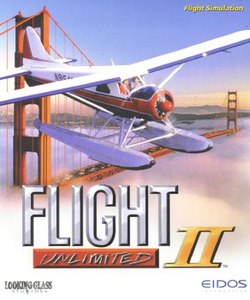Flight Unlimited II
| Flight Unlimited II | |
|---|---|

Flight Unlimited II box front cover.
|
|
| Developer(s) | Looking Glass Studios |
| Publisher(s) | Eidos Interactive |
| Platform(s) | Windows 95 |
| Release | December 12, 1997 |
| Genre(s) | Flight simulator |
| Mode(s) | Single player |
| Review scores | |
|---|---|
| Publication | Score |
| CGW | |
| PC Gamer (UK) | 91% |
| PC Gamer (US) | 92% |
| PC Zone | 8.4 out of 10 |
| Computer Games Magazine | |
Flight Unlimited II is a 1997 flight simulator video game developed by Looking Glass Studios and published by Eidos Interactive. The player controls one of five planes in the airspace of the San Francisco Bay Area, which is shared with up to 600 artificially intelligent aircraft directed by real-time air traffic control. The game eschews the aerobatics focus of its predecessor, Flight Unlimited, in favor of general civilian aviation. As such, new physics code and an engine were developed, the former because the programmer of Flight Unlimited's computational fluid dynamics system, Seamus Blackley, had left the company.
The team sought to create an immersive world for the player and to compete with the Microsoft Flight Simulator series. Commercially, Flight Unlimited II performed well enough to recoup its development costs. Critics lauded the game's graphics and simulated airspace, and several praised its physics. However, some considered the game to be inferior to Microsoft Flight Simulator '98. Following the completion of Flight Unlimited II, its team split up to develop Flight Unlimited III (1999) and Flight Combat (later Jane's Attack Squadron) simultaneously. Both projects were troubled, and they contributed to the closure of Looking Glass in May 2000.
Flight Unlimited II is a flight simulator video game: its gameplay is a simulation of piloting real-world planes. Players may control the Piper PA-28R-200, de Havilland Canada DHC-2 Beaver, Beechcraft Baron 58, North American P-51D Mustang or Cessna 172. The interactive cockpit of each plane is based on its real-world counterpart, and it contains simulated flight instruments such as an airspeed indicator, a heading indicator and a VOR indicator, among others. The player begins by engaging in a Quick Flight or by using the fixed-base operator (FBO) interface. In a Quick Flight, the player selects a plane and the flying conditions before taking off; the FBO interface features additional options, such as lessons, flight plans and adventures. The game's six lessons detail such maneuvers as takeoffs and taxiing. Adventures are pre-built missions, with objectives such as landing on an aircraft carrier, helping a prisoner to escape from Alcatraz Island or dropping turkeys into Candlestick Park. There are 25 adventures in total.
...
Wikipedia
